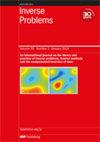具有导电边界的各向异性散射体的单调性方法分析
IF 2
2区 数学
Q1 MATHEMATICS, APPLIED
引用次数: 0
摘要
在本文中,我们将考虑与具有导电边界的各向异性介质相关的反向散射问题。我们将假设相应的远场模式是已知的/测量到的,并考虑两个反问题。首先,我们将证明远场数据能唯一确定边界系数。接下来,由于已知各向异性系数并非由该数据唯一确定,我们将开发一种定性方法来恢复散射体。为此,我们将研究应用于这一反形状问题的所谓单调性方法。这种方法最近被应用于一些反向散射问题,但这是它首次被应用于各向异性散射体。这种方法可以通过考虑与远场算子相关的算子的特征值来恢复散射体。我们将介绍一些简单的数值重建,以说明我们的二维理论。为了进行重构,我们需要将赫格洛茨波函数的邻接值计算为映射到小球 H1 的算子。本文章由计算机程序翻译,如有差异,请以英文原文为准。
Analysis of the monotonicity method for an anisotropic scatterer with a conductive boundary
In this paper, we consider the inverse scattering problem associated with an anisotropic medium with a conductive boundary. We will assume that the corresponding far–field pattern is known/measured and we consider two inverse problems. First, we show that the far–field data uniquely determines the boundary coefficient. Next, since it is known that anisotropic coefficients are not uniquely determined by this data we will develop a qualitative method to recover the scatterer. To this end, we study the so–called monotonicity method applied to this inverse shape problem. This method has recently been applied to some inverse scattering problems but this is the first time it has been applied to an anisotropic scatterer. This method allows one to recover the scatterer by considering the eigenvalues of an operator associated with the far–field operator. We present some simple numerical reconstructions to illustrate our theory in two dimensions. For our reconstructions, we need to compute the adjoint of the Herglotz wave function as an operator mapping into H 1 of a small ball.
求助全文
通过发布文献求助,成功后即可免费获取论文全文。
去求助
来源期刊

Inverse Problems
数学-物理:数学物理
CiteScore
4.40
自引率
14.30%
发文量
115
审稿时长
2.3 months
期刊介绍:
An interdisciplinary journal combining mathematical and experimental papers on inverse problems with theoretical, numerical and practical approaches to their solution.
As well as applied mathematicians, physical scientists and engineers, the readership includes those working in geophysics, radar, optics, biology, acoustics, communication theory, signal processing and imaging, among others.
The emphasis is on publishing original contributions to methods of solving mathematical, physical and applied problems. To be publishable in this journal, papers must meet the highest standards of scientific quality, contain significant and original new science and should present substantial advancement in the field. Due to the broad scope of the journal, we require that authors provide sufficient introductory material to appeal to the wide readership and that articles which are not explicitly applied include a discussion of possible applications.
 求助内容:
求助内容: 应助结果提醒方式:
应助结果提醒方式:


